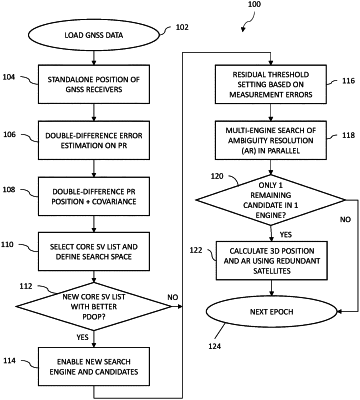| CPC G01S 19/44 (2013.01) [G01S 19/28 (2013.01); G01S 19/258 (2013.01)] | 15 Claims |

|
1. A system, comprising:
a first Global Navigation Satellite System (GNSS) receiver coupled to a first antenna;
a second GNSS receiver coupled to a second antenna;
at least one processor coupled to a memory, the first GNSS receiver, and the second GNSS receiver, wherein the at least one processor is configured to:
load GNSS data from the first GNSS receiver and the second GNSS receiver;
determine a standalone position of the first GNSS receiver and the second GNSS receiver using pseudorange observations;
perform error estimation using a double differenced code-based pseudorange;
determine a covariance using the double differenced code-based pseudorange;
select core satellites that provide a best position-dilution-of-precision out of all visible GNSS satellites and define a search space for ambiguity resolution by a first searching engine in its first epoch, wherein the search space for ambiguity resolution is larger than a code solution uncertainty;
determine a first list of candidates for ambiguity resolution using the core satellites;
adaptively set residual thresholds based on measurement errors;
eliminate candidates from the first list of candidates in response to a respective residual exceeding the adaptively set residual thresholds until a single candidate remains in the first list of candidates; and
determine position information using the single candidate remaining in the first list of candidates by applying ambiguities associated with the single candidate remaining in the first list of candidates;
wherein the at least one processor is further configured to:
determine whether a second group of satellites different than the core satellites have a better position-dilution-of-precision than the core satellites in a first new epoch subsequent to the first epoch;
in response to determining that the second group of satellites different than the core satellites have a better position-dilution-of-precision than the core satellites, the at least one processor is further configured to:
enable a second searching engine using the second group of satellites, wherein the second searching engine is configured to operate in parallel with the first searching engine;
determine a second list of candidates for ambiguity resolution using the second group of satellites;
eliminate candidates from the second list of candidates in response to a respective residual exceeding the adaptively set residual thresholds until a single candidate remains in the second list of candidates;
determine position information using the single candidate remaining from the second list of candidates by applying ambiguities associated with the single candidate remaining in the second list of candidates.
|